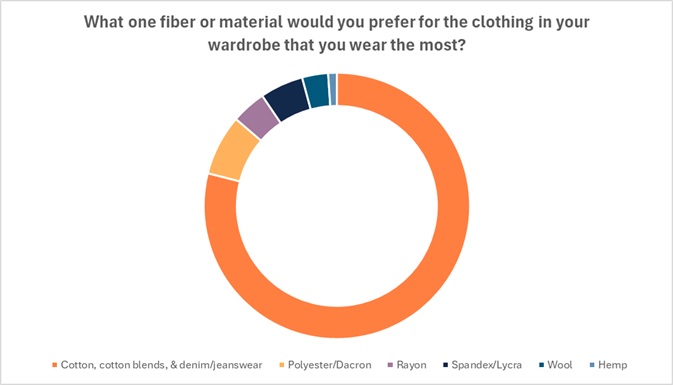Ever since 2019, World Cotton Day has been celebrated on October 7 to highlight the role cotton plays worldwide in job creation, poverty reduction and maintaining economic stability in cotton-producing countries, especially in least-developed countries.
A United Nations resolution for World Cotton Day acknowledges the vital role cotton plays, “by providing livelihoods and as a subsistence crop for millions of people, as well as its broader economic and social impacts around the world.”
It’s safe for the environment. It wears well and it lasts longer. We’re not in the business of making clothing to be disposed of. We’re in a business of making clothes to be worn in and passed on.
Reuben Shaw, designer and founder, Oxblood Zebra
Cotton is grown by about 24 million farmers in 80 different countries, according to the Food and Agriculture Organization (FAO) of the United Nations. Perhaps surprisingly, more than 43 percent of cotton farmers worldwide are women, according to the International Cotton Advisory Council (ICAC). It says often, but not for cotton growing, these women have no other source of employment outside the home. The ICAC says every tonne (2,204 pounds) of cotton provides year-round employment for about 5 people. Globally, that adds up to jobs and incomes for approximately 100 million people each year.
Besides providing economic stability, cotton can also be a source of sustainability for the textile and fashion industries. Consider that although it uses just 2 percent of the world’s farmable land, it meets 27 percent of global textile needs, according to the World Trade Organization. The WTO also points out that cotton is a drought-resistant crop with a deep root system that is ideal for arid climates where drought is a serious threat. Seasonal rainfall is sufficient to produce a high yield.
Here in America, the United States Department of Agriculture (USDA) describes cotton as “one of the most important textile fibers in the world,” saying it averages about 25 percent of total world fiber use. The department goes on to say the U.S. is the world’s third-largest cotton producer and the leading cotton exporter, accounting for a third of global trade in raw cotton. The U.S cotton industry accounts for more than $21 billion in products and services annually, generating more than 125,000 jobs in the sectors that range from farms to textile mills.
These economic numbers are driven by cotton’s global popularity. Fully 75 percent of consumers across 13 countries prefer the clothing they wear most to be made of cotton, cotton blends or denim, according to Cotton Council International (CCI) and Cotton Incorporated’s 2025 Global Lifestyle Monitor™ (n=13,026 people). These three fabrics are overwhelmingly preferred over manmade fibers including polyester (7 percent), spandex (5 percent) and rayon (4 percent). Cotton also eclipses natural fibers like wool (3 percent) and hemp (1 percent).

At the recent New York Men’s Day (NYMD) shows, held during New York Fashion Week, Reuben Shaw, designer and founder of Oxblood Zebra, explained to the Lifestyle Monitor™ in an interview at the show why he prefers to use all natural fibers in his collection, with a number of pieces for Spring 2026 using only 100 percent cotton.
“It’s just better,” Shaw told the Lifestyle Monitor™. “It’s safe for the environment. It wears well and it lasts longer. We’re not in the business of making clothing to be disposed of. We’re in a business of making clothes to be worn in and passed on.”
This is a sentiment held by consumers worldwide. In the 2025 Global Lifestyle Monitor™ survey, most respondents (59 percent) say clothing made from cotton is the best quality. The figure increases significantly to 69 percent among consumers in Mexico and India, and to 62 percent among German respondents.
Global consumers also say clothing made from cotton is the most comfortable (67 percent), according to the 2025 Global Lifestyle Monitor™ research. The number jumps to 81 percent among Mexican consumers, followed by India (73 percent), and Germany and the U.S. (both 69 percent).
Most consumers are also willing to put their money where their mouth is: nearly 6 in 10 (59 percent) are willing to pay more for clothing made from natural fibers such as cotton, according to the 2025 Global Lifestyle Monitor™ research.
Designer Bryan Jimenéz understands why consumers are willing to pay a premium for cotton. He, too, presented his Spring 2026 collection at NYMD, a showing that featured sculptured denim, tees and woven plaid shirts and shorts. He says cotton is his preferred fabric because it’s a natural fiber, it’s comfortable, “And I feel like I can do a lot with it,” Jimenéz told the Lifestyle Monitor™ in an interview. “It’s not limited.”
Despite cotton’s nearly unlimited usages, this year’s World Cotton Day program will highlight the challenges as well as the opportunities facing the cotton sector. A webcast will stream from the FAO headquarters in Rome, Italy, and will include two segments that the FAO says are designed to inspire action and showcase innovation. One will focus on the next generation of young designers, students, and entrepreneurs who will showcase creative uses for cotton, from concept to finished product. The second segment will explore “how artisanal processing can foster locally led development of the sector.”
Official discussions during the World Cotton Day celebration will “underscore the importance of enhancing productivity at all levels, explore strategies for adding value along the cotton value chain, and highlight the role of trade in strengthening the sector’s sustainability, while working toward a better future for all.”
